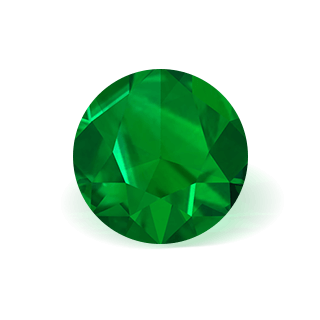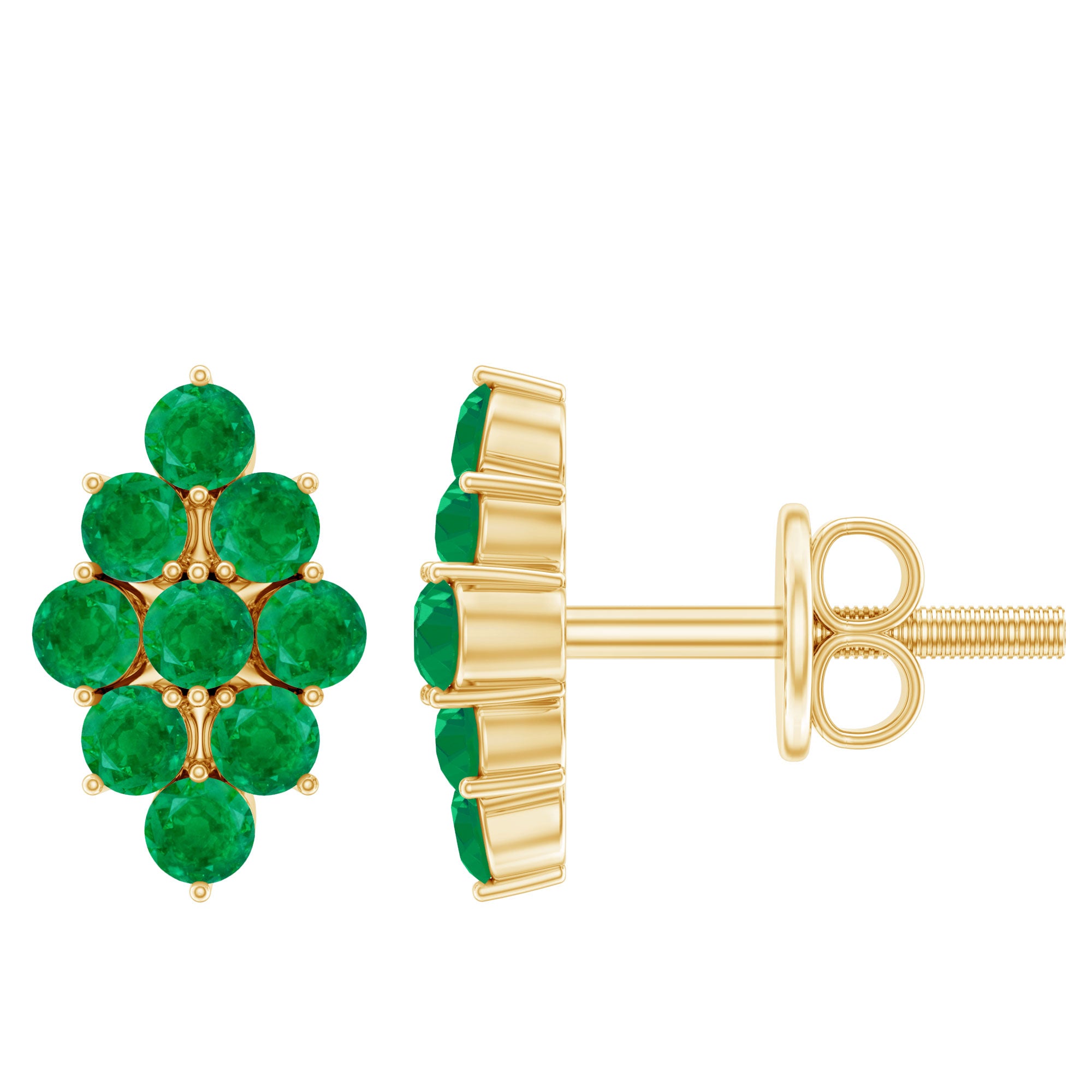All About Emerald: Types, Colors, Description, Origins & Details
Have you seen anything as vigorous yet royal as this beauty rich in green: Emerald! The name itself means green! The youthful and lifelike beauty of this May birthstone can certainly make anyone go all awe! Who doesn’t love the color of nature after all?
An alluring, serene and royal May birthstone indeed! We’re all an admirer of its beauty but don’t you think being a little more familiar with this gemstone would only help us make a better decision while buying it? To facilitate you with just that, Our Emerald education guide is here to address all the basic knowledge revolving around emerald including the famous 4 C’s, properties along with some interesting history and beliefs. It’s going to be an informative yet fun journey. Stay intact!
Properties of Emerald
Hardness
Who says gemstones cannot be worn on a regular basis? Having a hardness of 7.5 to 8 on Moh’s scale, Emerald is certainly a durable gemstone, perfect to be worn on a regular basis.
Luster
Thanks to the presence of Beryl, Emerald is known to possess a vitreous luster with high transparency free of any color zoning.
Size
According to the standard size, a 1 CT Emerald is known to have a size of 7x5 MM.
Origin & History
Where did this beautiful gemstone that is so proudly adorned by the likes of royalty come from? Let’s bless acquaint you with some emerald education along with a twist of fun! Well, Emerald is known to be mined from Egypt dating back to 330 BC. Its vigorous beauty had mesmerized Cleopatra, the queen of Egypt who fondly adorned it in her ornaments. Incas had also started laying it in their jewelry. The hidden mines of Emerald were discovered in North America by Spanish around 16th Century. Folklore suggest that Emerald was one among the four stones gifted by gold to king Solomon, further adding to its value. Having ties with goddess Venus, Emerald has long been hailed as a perfect jewelry gift for that special someone!
Where is Emerald found?
The largest producer of this precious May birthstone is Columbia, possessing 50 % of Emerald mines, followed by Zambia and Brazil. Talking of its specific formation, Emerald are mostly formed under intense temperatures in hydrothermal veins in pegmatite deposits under metamorphic environment. You can also find them in limestone or shale rocks. It gets its green color, thanks to the presence of Beryl, a mineral.
Natural Emerald versus Lab Created Emerald

Natural Emerald
A natural emerald, known to be grown in pegmatite rocks, do contain more inclusions and flaws which is pretty common and even add to the value of Emerald. These are also on the pricey side, thanks to its natural occurrence. These are also more rare to find and thus, highly sought after.

Lab Created Emerald
A Lab Created Emerald, possesses similar chemical and physical properties, just formed by recreating similar environment in the lab. It consists lesser inclusions and blemishes than their natural counterparts and thus, are known for being an inexpensive alternative to them.
Emerald Quality and Price Filters
Thinking how to buy emerald holding a top notch quality? Well, the 4 Cs of emerald: cut, color, clarity and carat, dominate its quality and to make you a better judge of that, let’s familiarize you with these a bit:
Color
Or shall we say the C that makes it so alluring! And yes, the vibrant green color of Emerald also comes with its range of different shades having medium to vivid color saturation. The rule of judgment is: Richer the green, more the value:
- Light Yellow Green: Light colored Emerald with a hint of yellow are ranked the lowest in value and in fact a light emerald is often termed as beryl.
- Light Blue Green: Light green emerald with a hint of blue is also no that prized as compared to its greener counterparts.
- Strong Yellow Green: Being more in value than its lighter counterparts, an Emerald rich in yellow-green color, possesses more color saturation.
- Strong Blue Green: An emerald strong in blue green color is usually found in Zambian mines, and is known to be the most sought after and valuable emerald, thanks to its appealing color.
- Intense Green: An emerald rich in green color is largely found in Columbia and is the most valuable and thus pricey variety of Emerald.
Clarity
Like most of the gemstones found in the Earth’s crust, Emeralds are no different when it is said that clean and clear emeralds are rare to find. The green gemstone can be found with a number of inclusions but black and yellow spots, cracks, fissures are among the common.
However, unlike diamond, no official scale can be found to categorize the amount of flaws. And yet, impurities in case of emeralds are not only accepted but also admired. The unique fingerprint found in an emerald can remind of the story of its own creation.
Carat
The weight of emeralds is another determining factor of its price and typically ranges between 0.01 to 2 CT in our collection.
Cut
The weight of emeralds is another determining factor of its price and typically ranges between 0.01 to 2 CT in our collection.
Emerald Grading Value
Here we come The old school grading system yet equally efficient grading system of gemstones. Typically what helps you judge the quality of your May birthstone better, precisely the color and clarity. Take a look at our emerald education chart:
AAA
The top 10 % of Emerald belonging to this category are usually intense green in color, possess clarity with medium to slight inclusions along with top notch brilliance.
AA
The top 20-30 % of Emerald belonging to this category are known for being medium green in color along with included clarity.
A
The 50-70 % of Emerald belonging to this category, are known to be heavily included with flaws and blemishes along with being a little lighter in color. Precisely, the least valuable out of the lot!
Benefits of Emerald
A glance at Emerald can fill you with joy and some kind of youthful energy. Such is the beauty of this vibrant color May birthstone! Having strong ties with Mercury planet, an Emerald is known to possess some wholesome benefits. Let our emerald guide give you a glance:
Physical Healing
Probably what attracts us all! Since long, Emerald has been known to be associated with heart chakra and thus helping with heart and kidney problems along with getting rid of toxins in liver. Specially advantageous for the diabetic patients, Emerald can help with circulatory function and lung diseases as well.
Mental Healing
Here is something that you wouldn’t so easily find in other gemstones. Emerald is known to help the wearer sharpen his mind by enhancing his reasoning as well as arithmetic abilities, thus imparting more wisdom and intellect in him/her. Apart from that, it also soothes the mind of the wearer and enhances his clarity of mind.
Metaphysical Benefits
Being hailed as a life affirming stone, which we bet you can tell from its lifelike green color, Emerald is known to strengthen unconditional love, friendship and peace in the life of the wearer. Basically, everything that we’re chasing in life.
Frequently Asked Questions
How is an Emerald made?
Emerald or else called as natural beryl in scientific terms, are formed when beryllium is bubbled up from Earth’s crust into hydro-thermal veins. The beryl is believed to take growth in the form of hexagonal crystals and the signature green color is owed to the presence of trace elements such as chromium and vanadium.
What is difference between lab grown and natural Emeralds?
Like most of the gemstones, there is an option to choose between natural and lab-created Emeralds. One must not confuse “lab grown” with the “fake”. While synthetic is a replica the lab grown is developed in a controlled lab environment.
The most notable differences between them include that naturally occurring emeralds have many inclusions or variations as compared to it lab grown counterpart which is free from any such inclusions. The Lab Grown Emeralds can lack the expected color and saturation.
Where do Emeralds come from?
Emeralds are even less common from the diamonds. The most recognized places which contribute to the supplies of emeralds in the world include Columbia, Brazil, and Zambia.
How to take care of Emerald Jewelry?
Emerald Jewelry is quite easy to clean due to their hardness and durability. However, a few things must be kept in mind like avoiding contact of the gemstone with make-up, harsh chemicals, abrasives.
While cleaning the jewelry make use of lukewarm water and mild cleaning detergent. Soft toothbrush can be used to clean the underside of the emerald.
Also, the jewelry must be individually kept to avoid contact with other jewelry to avoid unnecessary scratches.
What is a Emerald certification?
The most common Emerald Certifications includes from GIA, SGL and HRD labs. It is usually a document you receive on the behalf of the aforementioned 3rd party labs which describes an emerald in all of its characteristics.
Each and every party’s defining grounds may defer.
Can Emerald go in water?
Yes, Emerald can go in water but it is advisable to not keep them in water for long intervals. Apart from that, it should also be kept away from long exposure to harmful chemicals, typically contracted with while taking a shower or in swimming pool.
Are Emeralds rare?
Emeralds can be mined from all over the world including Africa and America but since they are known to have more inclusions than any other gemstone across the world, a high quality Emerald is usually the rarest to witness with only top 10 % of them belonging to the AAA category.
Is Emerald durable?
Emerald is known to possess a hardness of 7.5-8 on Moh’s scale and thus can withstand the wear and tear of regular use with much ease. That makes it a pretty durable precious gemstone.
Conclusion
All hail the beauty in green: Emerald. This May birthstone is known for its vibrant, joyful and lifelike beauty. The beauty that fails to impress! Since we’re always going gaga over the royal yet youthful beauty of this precious gemstone, why not get some Emerald education ourselves. Would only help us make a better decision while buying them, isn’t it? And we say when we’re so fantasized with something, it doesn’t hurt to make ourselves more familiar with it. That’s exactly why we have come up with emerald guide covering the fun history and origin to its benefits, properties and of course, the famous 4 Cs. We hope we got you glued to your seats and you’re going away much more informed about this May birthstone. Here we sign of wishing you all the luck!




